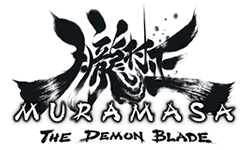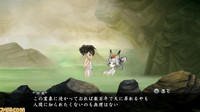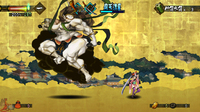|
|

|
PLATFORM
|
Wii
|
BATTLE SYSTEM
|

|
INTERACTION
|

|
ORIGINALITY
|

|
STORY
|

|
MUSIC & SOUND
|

|
VISUALS
|

|
CHALLENGE
|
Easy
|
LENGTH
|
Less than 20 Hours
|
|
OVERALL

|
+ Amazing 2D visuals.
+ Solid, engaging gameplay.
+ Map markers make it hard to get lost.
- Short, even with two stories.
- Stories are cut and dry.
- Dialogue is bland.
|
Click here for scoring definitions
|
|
|
Muramasa: The Demon Blade has a very interesting history behind its localization. The game swapped teams after being announced by one publisher, and ended up in the hands of Ignition Entertainment. Putting that drama aside, Muramasa is what Vanillaware director George Kamitani referred to as Princess Crown 3, the spiritual follow-up to Odin Sphere. It is one of the most visually impressive 2D games that I've ever seen, but what about the rest of it?.
Let's get the graphical praise out of the way first. Muramasa looks like a watercolor painting come to life with every little detail in the background as vivid as can be. While some of the explorable areas do appear to repeat after awhile, the scenery is amazing regardless. The beach stages with crashing waves are so beautiful it will have some gamers stopping just to admire them. The rain-soaked areas are dark and dreary, helping to drum up the perfect atmosphere for the locale. The flowing waterfalls and gorgeous sunsets are enough to impress gamers who normally don't even care about graphics.
The character designs are also spectacular. The main characters, Kisuke and Momohime, are both beautifully drawn, though they only vary from their normal outfits at a few points within the game. That includes the gratuitous hot springs scenes, where the female Momohime is only covered in the front by a towel. The other NPCs are equally well drawn, but the most impressive designs belong to the game's bosses. Whether fighting an overgrown spider, a humongous foot, or a half-naked thunder god, these battles are the highlights of Muramasa.
 Not as much T&A as you would imagine.
Not as much T&A as you would imagine.
|
|
However, games are more than just a pretty face. There has to be something else to make it worth playing and thankfully Muramasa's combat is rewarding, if a bit simple. Whether the player selects Kisuke or Momohime, the basics of combat will be the same. Gamers will travel all over Japan, moving from zone to zone across the world map. Players won't be battling every step of the way, as enemy squads will launch random attacks only sporadically. While some inexperienced players could likely button mash their way through most of the game on the lower difficulty setting, it wouldn't be very effective. Players will need to take advantage of multi-hit combos and aerial attacks to have the best chance of survival.
There are two different styles of katana to equip: quicker, weaker blades or slow, stronger long blades. Only three can be equipped at a time, but 108 total are available to be found or forged throughout. Swords will break when their soul power has been drained. This happens after repeated parries, repelled attacks, or in using the katana's secret art, a combat maneuver that is unique to each blade. Since this happens often, it's necessary to swap between the three during battles for the broken blade to repair. Doing so will unleash a powerful quick draw attack that damages all enemies on screen, though this ability has a recharge timer to prevent abuse.
Item usage is fairly straightforward. Items are usually food and can be used to restore health and soul power for swords, but many will also boost spirit points. Spirit is used in conjunction with souls, which are gathered from defeated enemies, to forge new blades. So while players might not need to eat to recover health very often, it is still required to upgrade weapons. Players can take up cooking to create their own dishes or they can purchase food. Food varies though, as each dish eaten will increase the character's fullness meter and until that meter empties, nothing else may be eaten, so it's important to watch what is ingested, and how often, during combat.
 Ok, maybe there is.
Ok, maybe there is.
|
|
Muramasa does a fine job of being accessible. Save points are available fairly often and will restore health when used. The game automatically creates a map as new locations are explored, and maps can also be purchased to reveal the full area. The map function always directs players to the next location they need to visit, so it's impossible to get Lost. However, barriers that are unlocked as the game progresses can prevent exploration outside of the game's linear path. While Muramasa is easily playable with the Wii Remote and Nunchuk, it also offers the option of using the classic controller or a GameCube controller. Another unique feature of the game is that Kisuke and Momohime's stories can be played interchangeably by alternating between them. The game's difficulty can also be modified at any time between the easier Muso mode and the harder Shura mode.
One debatable aspect of Muramasa is its audio quality. The music is handled by Hitoshi Sakimoto and his music production company Basiscape, and most all of it is very fitting for the Japanese style of the game, so no complaints there. The game features a good bit of voice acting, but Ignition opted to leave all of the voices in the original Japanese. While it does fit with the game's overall theme, some might be dismayed by the lack of English.
The game's translation is also fairly cut and dry, but so is the story. Momohime and Kisuke each have their own storylines, but neither are extremely engaging. Momohime has to cope with being possessed by an evil spirit, and Kisuke seeks to regain his lost memories and find out why he's been labeled a traitor. Momohime's arc is very one-dimensional while Kisuke's is much more captivating, but neither really have a powerful impact overall.
When you look at and play Muramasa, it is a great game. The visuals are some of the best 2D I've encountered, and the character designs and bosses are very original and creative. The gameplay is very addictive and fast-paced, never really dragging during each character's arcs. Both arcs are quite short, only lasting about five or six hours apiece. Even gamers who don't usually like action-focused RPGs might find themselves hooked. However, don't go into Muramasa expecting an impressive story. For gamers that want an experience full of beautiful scenery and engaging gameplay, Muramasa will provide just that.
Review Archives
|









